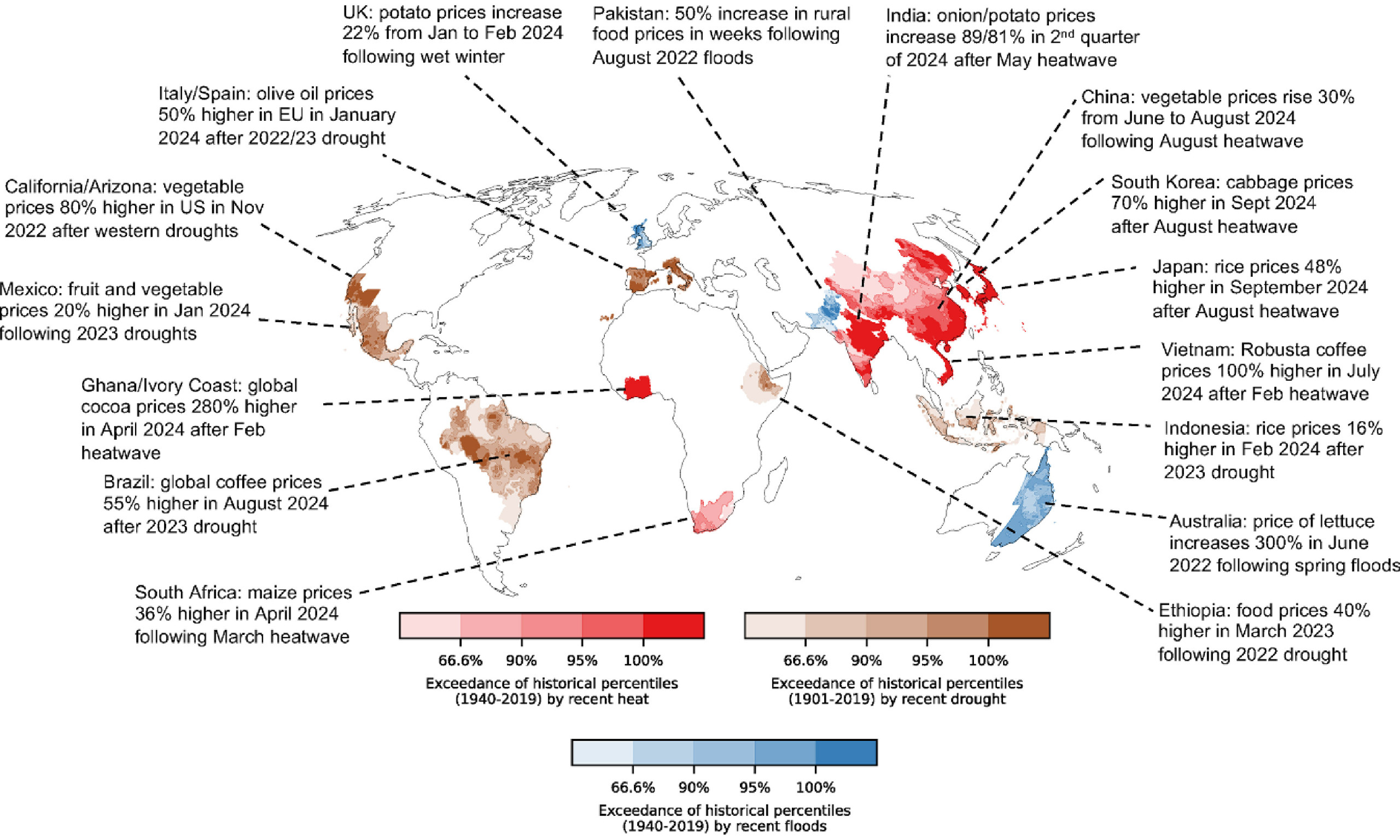In recent years, our planet’s weather has grown more volatile and is now hitting us right where it hurts: our wallets and dinner tables. A new study, led by Maximillian Kotz from the Barcelona Supercomputing Center, reveals how climate-driven extremes have triggered a sharp rise in food prices across the globe.
Between 2022 and 2024, researchers looked at 16 climate-related cases in 18 countries. In each scenario, sudden shifts in weather patterns sent food costs soaring, disrupting not only local economies but also affecting global supply chains. From vegetable fields in California to coffee plantations in Brazil, the message was the same: extreme weather makes basic food more expensive.
The study found record-breaking temperatures triggered massive price shifts in Asia last year, particularly in South Korea, Japan, China, and India. In just one year, Korean cabbage prices spiked by 70%, Japanese rice by 48%, and Chinese vegetable prices surged by 30% between June and August. These were not just seasonal price blips; they were caused by unpredictable weather events unlike anything seen before 2020.
All continents feel the strain
In the United States, California and Arizona, major hubs for vegetable production, the picture was the same due to the unprecedented drought in 2022, leading to vegetable prices across America spiraling by 80% in just one year.
In Southern Europe, due to another historic drought that hit Spain, olive oil prices across the EU jumped up by 50% last year which followed a steep rise in the previous year.
In another part of the world, Ghana and the Ivory Coast, which together meet most of the world’s cocoa demand, experienced abnormal heat in February 2024, meaning cocoa prices had already tripled by April of the same year. Similar patterns played out in Vietnam and Brazil, where heat and drought damaged coffee crops, pushing prices up for consumers.
In Australia, floods and droughts have driven food prices up by 20% since 2020. Essentials such as bread, beef, and dairy products have seen spiraling prices, with other items like lettuce rising by 300%.
A warning from climate scientists
Commenting on the situation, Kotz, who also works with the Potsdam Institute for Climate Impact Research, said:
“Until we get to net-zero emissions, extreme weather will only get worse, and it’s already damaging crops and pushing up the price of food all over the world.”
According to him, rising grocery bills are now the second most common climate-related concern for people around the world, after extreme heat.
The human cost: hunger, poor nutrition, and public health crisis
When food becomes more expensive, low-income households are hit the hardest. Some may be forced to skip meals, others might have to switch to cheaper, less nutritious options. In the United States, the poorest families spend about one-third of their income on food, compared to just 8% among the wealthiest. And in hotter, poorer countries, the burden is even heavier.
The study also points to a growing public health concern. As people are pushed toward lower-cost, processed foods, the quality of diets can plummet, raising the risk of:
- Malnutrition
- Diabetes
- Heart disease
- Cancer
However, the effects of food insecurity go beyond physical health. It is increasingly linked to mental health challenges, particularly for children whose development depends on adequate nutrition.
Spiraling inflation, political instability
There is also a broader economic ripple effect. Food prices fuel inflation, which poses a challenge for central banks that are trying to maintain price stability. Developing countries are especially vulnerable, as food accounts for a larger share of household budgets and national inflation baskets. If climate extremes continue to trigger volatile price swings, keeping inflation under control may become more difficult, forcing hikes in interest rates that could, in turn, slow economic growth.
And then there is the political risk. Throughout history, food shortages and price spikes have played a role in civil unrest, protests, and even regime change. Studies show a strong link between rising food costs and social tension. High inflation can affect elections, lower trust in governments, and boost support for radical political movements.
Ultimately, what begins as a shift in weather patterns becomes a cascade, affecting what we eat, how much we pay, our health, our politics, and even our sense of stability. The science is clear: climate extremes are no longer distant threats. They are already reshaping our world.

Source: Climate extremes, food price spikes, and their wider societal risks

